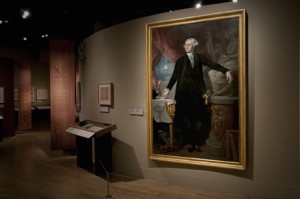 With the able help of UNM professors (Rebecca Sanchez, Mercedes Valenzuela and Ron Taylor) , the History Museum is proud to announce the online addition of lesson plans to help teachers deepen students’ understanding of the exhibition The Threads of Memory: Spain and the United States. The exhibition, on loan from the General Archive of the Indies in Spain, is making its U.S. debut at the museum through Jan. 9. (It then travels to El Paso and New Orleans before heading back to Spain — making this a rare opportunity to see it.)
With the able help of UNM professors (Rebecca Sanchez, Mercedes Valenzuela and Ron Taylor) , the History Museum is proud to announce the online addition of lesson plans to help teachers deepen students’ understanding of the exhibition The Threads of Memory: Spain and the United States. The exhibition, on loan from the General Archive of the Indies in Spain, is making its U.S. debut at the museum through Jan. 9. (It then travels to El Paso and New Orleans before heading back to Spain — making this a rare opportunity to see it.)
Why does it matter? The first known European chronicles describing the lands and native peoples of what is now the United States were written not by pilgrims but by Spanish explorers. Spain’s presence on the continent evolved over 309 years—from April 12, 1513, when Juan Ponce de León took possession of the Florida coast for the king of Spain, to 1822, when a newly independent Mexico lowered the Spanish flag in California. Created in Spain, The Threads of Memory explores a heritage that most Americans missed in their American History classes.
Many of today’s issues – immigration, land grants, cultural traditions, and complex interrelationships among cultures – can be traced to how our predecessors responded to Spain’s role in the American story. When history books too often told the American story from an east-to-west point of view, the role played by Spain faded into the background, if it was even mentioned at all.
 Many of us were taught how important France’s aid was to achieving U.S. independence, but far fewer know that Spain’s financial aid essentially underwrote the American Revolution.
Many of us were taught how important France’s aid was to achieving U.S. independence, but far fewer know that Spain’s financial aid essentially underwrote the American Revolution.
We also know that President Thomas Jefferson purchased Louisiana from France, but we may not know that, just one month prior, Spain had ceded Louisiana to France.
The exhibition is organized in 10 sections, including the first accounts of geography; the development of missions, forts, roads and cities; land exchanges among Spain, France and the United States; the threat from Russian exploration and colonization; and the Revolutionary War. The exhibit includes details of Spain’s explorations and settlements in modern-day Florida, Louisiana, Texas, New Mexico, California and Oregon.
We encourage teachers and homeschoolers to take advantage of the opportunity to fill in the gaps.
The lesson plans are geared to a variety of age groups, encourage individual and group work and provide an early learning lesson in the importance of working with original documents.
The Threads of Memory: Spain and the United States (El Hilo de la Memoria: España y los Estados Unidos) is sponsored by the Fundación Rafael del Pino and, along with the Archivo General de Indias (General Archive of the Indies), and is co-organized with SEACEX (Sociedad Estatal para la Acción Cultural Exterior), in collaboration with Spain’s Ministries for Foreign Affairs and Cooperation and Culture. The exhibition and lecture series are presented in New Mexico with special support from BBVA Compass Bank, the city of Santa Fe, Wells Fargo Bank, Heritage Hotels, Santa Fe University of Art & Design, the Museum of New Mexico Foundation, the Palace Guard, and many individual donors.
